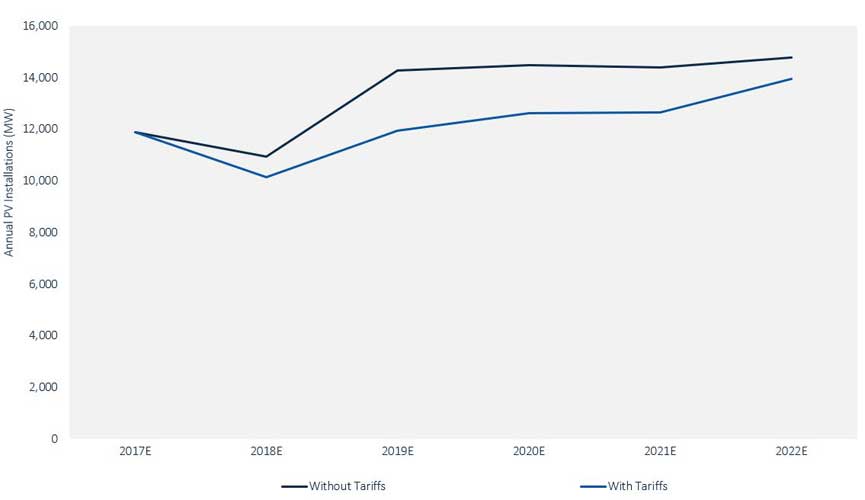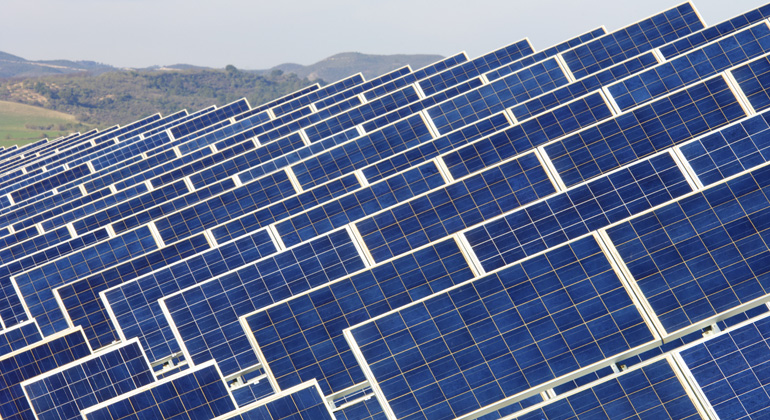New Tariffs to Curb US Solar Installations by 11% Through 2022
Emerging solar markets, including the home states of the two trade case petitioners, will be among the hardest hit, according to the latest analysis from GTM Research.
President Trump’s decision on the Section 201 solar trade case could have been worse for the U.S. solar market — but it certainly isn’t good news.
The administration unveiled tariffs yesterday that were less severe than the remedies requested by trade case petitioners Suniva and SolarWorld Americas. Trump ultimately approved a 30 percent solar import tariff for crystalline-silicon solar cells and modules, which steps down by 5 percentage points each year to 15 percent by the fourth year. In addition, 2.5 gigawatts of cells are exempt from the tariffs each year.
So what does this mean for the U.S. solar industry?
“Essentially, this has a meaningful but not destructive impact on solar installations, and at the same time it’s not exceptionally encouraging for domestic solar cell and module manufacturing,” said MJ Shiao, head of Americas research for GTM Research. “Some people look at it as a win-win; some people look at it as a lose-lose.”
GTM Research issued a revised forecast today that finds the U.S. solar market will see a net reduction in installations of around 11 percent as a result of the new tariffs. That translates to a cumulative 61.3 gigawatts of solar deployed over the next five years compared to an original projection of 68.9 gigawatts, for a 7.6-gigawatt reduction in installed solar PV capacity between 2018 and 2022.
The tariffs result in an average 10 cent per watt increase in year 1 prices for modules, stepping down to a 4 cent per watt premium by year 4.
Utility-scale solar will take the brunt of the impact, accounting for 65 percent of the anticipated 7.6-gigawatt decline. 2019 is expected to be the most painful year for the utility-scale sector, with a 1.6-gigawatt decline in installations compared to GTM Research’s original forecast. 2018 is relatively insulated from the tariffs, with a forecast decline of 525 megawatts, because many installers locked in their module orders early in anticipation of trade action.
Annual U.S. PV Installation Reductions Due to Tariffs by Segment
“The reason why we think the 2018 impacts are muted is because we think there were somewhere between 2 to 3 gigawatts of modules in the U.S. by the end of the year basically dedicated for projects in the works — projects under construction to come online in the first half of the year or allocated modules for projects that will begin construction in early 2018,” said Shiao.
“So that kind of dampers the economic impact,” he said. “Later this year and in 2019 — when people start to buy more modules fully affected by the tariffs — the full impact sets in.”
Even with the new tariffs, GTM Research expects the industry to deploy more than 10 gigawatts of solar installations in the U.S. this year, and 11.9 gigawatts next year, with continuous growth through 2022. But that growth will be at a slower pace than initially expected.
The new analysis shows that new and emerging state solar markets are disproportionately affected by the tariffs, with Southern states like Texas, Florida and South Carolina among the most significantly impacted by the tariffs. Oregon, the home state of trade case petitioner SolarWorld Americas, will be the eighth most affected solar market in the country. Georgia, Suniva’s home state, will be the fourth most affected market.
According to the Solar Energy Industries Association (SEIA), yesterday’s tariff decision is expected to cause 23,000 job losses this year, with job cuts remaining in the tens of thousands throughout the four-year tariff period.
On a call with reporters today, Abigail Ross Hopper, SEIA president and CEO, acknowledged that the outcome is not a death blow to the broader collection of U.S. solar companies — the vast majority of which opposed the Section 201 case.
“I think that this administration really grappled with the understanding that solar is creating jobs, more jobs in this economy than many other industries and many other energy sources,” she said. “A quarter of a million people are employed in this industry.”
Advocacy efforts led by SEIA and its allies, which included U.S.-based solar module manufacturers, utilities, a broad group of lawmakers, and conservative free-market groups such as American Legislative Exchange Council, “led to a decision we are not happy with, but does display restraint on behalf of the president,” Ross Hopper said.
Annual U.S. PV Installations With and Without Tariffs, 2017E-2022E
She underscored that the tariffs are a big deal for the thousands of people likely to lose their job this year, however. The 7.6-gigawatt reduction in U.S. solar installations through 2022 is meaningful.
“Those are significant numbers if you think about energy production, if you think about employment numbers, and certainly if you think about investments,” Ross Hopper said. “It means billions of dollars of lost investment across the country. Some 1.2 million homes won’t be powered by solar” as a result of the decision, she added.
For Suniva and SolarWorld Americas, meanwhile, it’s unlikely the tariffs are severe enough to reboot the U.S. solar cell and module manufacturing sector to their desired extent. Yet the petitioners both issued statements yesterday praising President Trump and adding that they are hopeful the remedies will be sufficient to rebuild solar manufacturing in the U.S.
“We look forward to working with the administration as these tariffs go into effect and beginning global settlement negotiations,” Suniva said. “This is a step forward for this high-tech solar manufacturing industry we pioneered right here in America.”
The Office of the U.S. Trade Representative confirmed to GTM that free-trade partners Canada, Mexico and South Korea are not exempt from the global safeguard measures announced yesterday. SEIA said it is expecting exemptions for certain solar products, such as solar-powered backpacks. Whether or not the administration will issue exemptions specific solar panel technologies, such as high-efficiency panels, remains to be seen.
The USTR said yesterday that the Trump administration will “engage in discussions among interested parties that could lead to positive resolution of the separate anti-dumping and countervailing duty measures currently imposed on Chinese solar products and U.S. polysilicon.” But the full scope of those talks is not yet fully understood.
“I think there is a solution possible, and it could benefit the entire solar value chain,” said Ross Hopper. “SEIA stands ready to be a part of those conversations.”
More information will likely be revealed in the coming days when the president’s trade proclamation is published in the Federal Register. Based on precedent from previous Section 201 trade cases, U.S. trading partners are expected to mount a challenge to the new tariffs at the World Trade Organization in the coming months.










